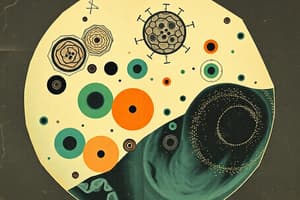Podcast
Questions and Answers
What is the largest type of cell mentioned?
What is the largest type of cell mentioned?
Nerve cell of a giraffe
What is the smallest type of cell mentioned?
What is the smallest type of cell mentioned?
Mycoplasma (bacteria)
Which of the following is NOT a shape that cells can take?
Which of the following is NOT a shape that cells can take?
- Funnel-shaped (correct)
- Slipper shape
- Rod-like
- Flat
All living things are composed of one or more cells.
All living things are composed of one or more cells.
Which of the following is a prokaryotic cell?
Which of the following is a prokaryotic cell?
Which organelle is known as the powerhouse of the cell?
Which organelle is known as the powerhouse of the cell?
The __________ serves as the boundary between the outside and inside environments of the cell.
The __________ serves as the boundary between the outside and inside environments of the cell.
What function do lysosomes serve in the cell?
What function do lysosomes serve in the cell?
Which organelle is involved in protein synthesis?
Which organelle is involved in protein synthesis?
Where does photosynthesis take place in plant cells?
Where does photosynthesis take place in plant cells?
Match the following types of cells with their categories:
Match the following types of cells with their categories:
Study Notes
Cell Characteristics
- Cells vary in size: largest is the nerve cell in giraffes (over 3m), smallest is mycoplasma (0.001μm).
- Cell shapes include:
- Rod-like (e.g., E. coli bacteria)
- Slipper shape (e.g., protozoan)
- Irregular (e.g., amoeba)
- Box/cube shape (e.g., plant cells)
- Flat (e.g., skin cells)
- Long and thin (e.g., muscle cells)
- Elongated with tentacles (e.g., nerve cells)
Cell Theory
- All living things are composed of one or more cells.
- Chemical reactions occur within cells.
- All cells originate from pre-existing cells.
- Cells contain hereditary information passed from generation to generation.
Cell Types
- Two basic types of cells:
- Prokaryotic: includes bacteria and archaea.
- Eukaryotic: includes protists, fungi, plants, and animals.
Cell Structure Components
- Main components: Nucleus and Cytoplasm.
- Nucleus: Information center; regulates substance passage in and out of the cell.
- Cytoplasm: Contents outside the nucleus, enclosed by the cell membrane; consists of cytosol and organelles.
Cytoskeleton
- A structured network of protein filaments maintaining cell shape and facilitating movements.
Cell Membrane Structures
- Plasma Membrane: Boundary between internal and external environments, made of lipids and proteins.
- Cell Wall: Common in plant cells and bacteria; provides support and protection.
Organelles in the Cytoplasm
- Endoplasmic Reticulum (ER): Passageway network for substances; includes rough (RER) and smooth (SER) types.
- Ribosomes: Dot-like structures located on RER; sites for protein synthesis.
- Mitochondria: Powerhouses of the cell; sites of respiration and ATP production; contain maternal DNA.
- Golgi Apparatus: Packaging station for synthesized proteins; abundant in cells that secrete proteins.
- Vacuoles: Membrane-bound sacs for storage, digestion, and waste removal; help maintain plant shape.
- Lysosomes: Known as "suicidal bags"; burst to release enzymes for digestion and waste removal.
- Chloroplasts: Found in plant cells; contain chlorophyll and are the sites of photosynthesis.
Comparison of Plant and Animal Cells
-
Both:
- Nucleus
- Cytoplasm
- Ribosomes
- Mitochondria
- Golgi Apparatus
-
Plant cells have:
- Cell Wall
- Chloroplasts
- Large central Vacuoles
-
Animal cells have:
- Lysosomes
- Smaller Vacuoles
Summary
- Understanding cell structure and organelles is crucial for grasping biological processes in organisms. Each component plays a specific role in maintaining the cell's health and function.
Studying That Suits You
Use AI to generate personalized quizzes and flashcards to suit your learning preferences.
Related Documents
Description
Test your knowledge on cell organelles and their functions with this engaging quiz. Explore the various shapes and sizes of cells, as well as the fundamental cell theory that underpins all life forms. Perfect for biology students looking to reinforce their understanding of cellular structures.




